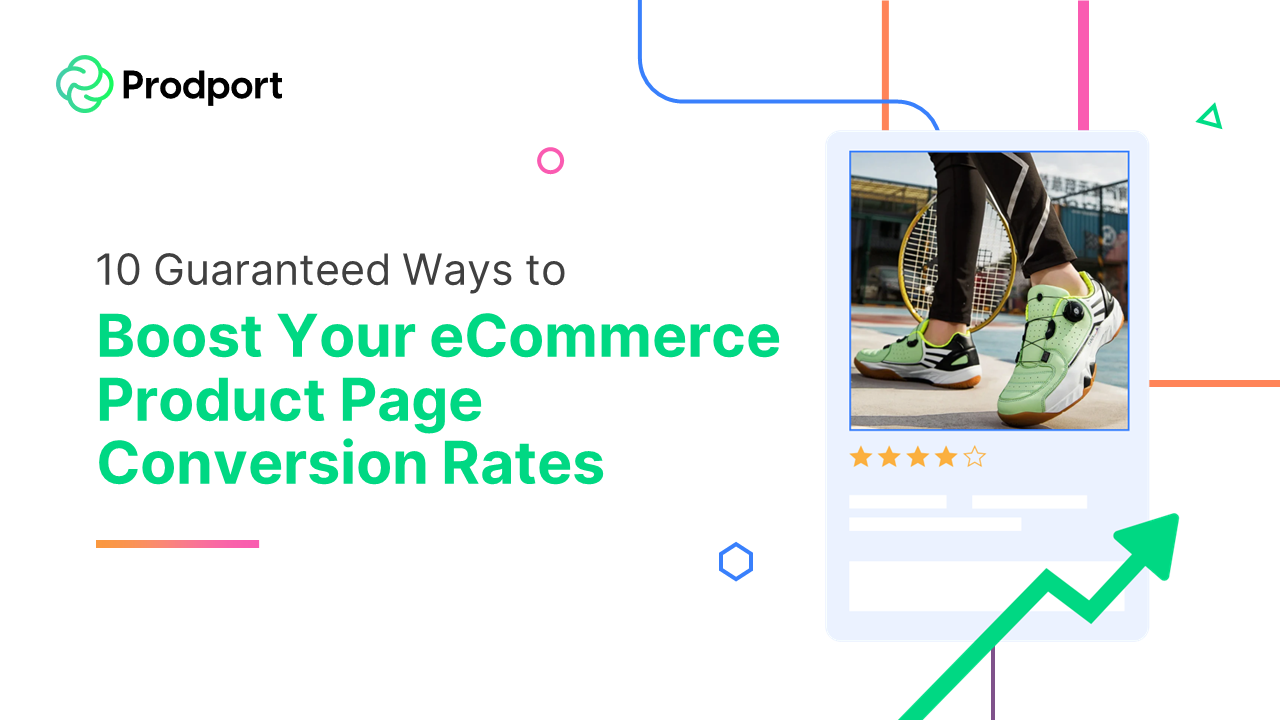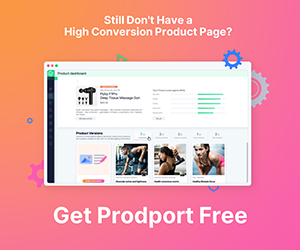They say that where there’s demand, there’ll always be supply. The ecommerce landscape has changed and grown significantly in the past few years – partly out of necessity and partly out of convenience.
On the one hand, this is a perfect opportunity for your ecommerce business to ride the wave and sell more to more people. On the other hand, this industry-wide growth attracts a lot of competition who want a piece of your pie.
But having a good online store and surpassing your past quarterlies is not enough. If you want your ecommerce site to flourish, you’ll need to outperform all the other companies rolling in on your territory as well.
Well, we’re here to help. In this article, we’ve compiled 10 guaranteed ways to boost your ecommerce product page conversion rate and grow your revenue. But let’s start here…
What is Ecommerce Conversion Rate?
First, let’s address the elephant in the room. We can’t answer how to increase the conversion rate if we don’t know what a “conversion” is. Although this depends on your company’s unique needs and desires, there are several things we consider eCommerce conversions.
Examples of eCommerce Conversions include:
- a purchase (our favorite conversion)
- a product added to the cart
- an added item to the wishlist
- an email sign-up
- social media share
In this article, we’ll focus on increasing sales, specifically. However, many of the 10 strategies outlined in this article can fulfill multiple uses, so don’t be afraid to think outside the box and experiment to meet your needs.
10 Guaranteed Ways to Boost Product Page Conversion Rates
Conversion Rate Optimization (CRO) is a complex process, often leveraging multiple aspects of your business (i.e., ecommerce store) to achieve your goals. Due to this, you need to evaluate your product pages from several different points of view, not only looking at what’s ON the page but BENEATH it as well.
1. Make Your Product Pages Easy to Find
One common ecommerce belief is that you should keep customers on your page for as long as possible. Counterintuitively, the best way to do that is to prioritize design that allows users to achieve their goals as quickly as possible.
A high bounce rate is one of the most common revenue stream killers caused by obscure and confusing navigation. The key to avoiding it is to offer a smooth and convenient online experience that won’t frustrate your target customer base. Consequently, they’ll be more likely to spend time browsing your site.
You can achieve this with these design best practices:
- Create a streamlined, comprehensive navigation bar.
- Add filters for easier browsing.
- Incorporate a Search function.
- Implement “Breadcrumbs” to make backtracking easier.
- Design with Mobile in mind.
2. Optimize Page Speed
According to Shopify, increasing website load speed by 1 second can boost ecommerce product page conversions by up to 27%. On top of that, it also helps lower your bounce and site abandonment rates and can improve your SEO ranking.
However, these benefits require you to invest time and effort in your back-end optimization.
Here are a few tips to help you improve your website load speed:
- Optimize media size with compression.
- Minimize HTTP requests by consolidating files and using CSS sprites.
- Enable browser caching for CSS and JavaScript.
- Distribute content across multiple servers with a Content Delivery Network.
- Use a fast web host.
- Reduce the number of plug-ins you use.
- Use a Content Management System (CMS) optimized for speed.
3. Understand Your Customer Journey
To get off on the right foot with your potential customers, you must create product pages matching the user’s specific search intent. But to do that, you first need to understand your buyer’s journey.
Here’s how to map out and get the most out of your customer journey:
- Analyze website data and evaluate user behavior.
- Differentiate between the various stages your customers go through.
- Pinpoint where your product pages fall into place.
- Assess how potential buyers interact with your product pages.
- Collect your learnings, find what works, and use it in the following steps to…
4. Personalize Your Product Pages
Product pages are the main driver behind any purchase decision, and you should optimize them to reflect that fact. But here’s the kicker – every Joe Schmoe does personalization nowadays, so it’s no longer enough to tweak your product page content statically. To stand out, you need to create dynamic product pages.
This means implementing photos, videos, headlines, product descriptions, and reviews that reflect the viewer’s search intent. And while this might be difficult to do on your own, Prodport makes it a breeze, and with no coding needed.
Our solution pinpoints the lead’s position in their buyer’s journey, automatically adapts to your product page’s layout, and swaps in AI and user-generated content the customer is most likely to respond to.
So far, this has resulted in up to 70% higher conversion rates and 20x ROI for our customers. But you can read about that in our Case Studies here.
5. Use Engaging Media
Images and videos affect how customers perceive and evaluate products.
Firstly, quality matters and grainy or blurry media isn’t appealing and will negatively reflect your page’s performance, so make sure everything’s nice and clean.
But secondly, and more importantly, the content of your media is even more vital. It increases customer engagement, reinforces your products as high-quality and valuable, enhances credibility, and works with your copy to boost conversions.
These positive effects can be further strengthened by incorporating user-generated content and interactive media like 360° videos and virtual tours.
6. Create Detailed Product Descriptions
Copy is the second piece of the puzzle for high-conversion product pages. Headlines create pre-conceived notions of the product’s use, quality, and benefits. Descriptions help solidify these feelings by offering additional information, ideally tailored to resonate with your target demographic.
Furthermore, good headlines and descriptions help prevent product returns by setting accurate expectations with precise details, differentiating your product from competitors, and improving SEO with keywords.
Here are a few recommendations to help you get the most from your copy:
- Be descriptive and use vibrant, evocative language.
- Be concise not to overwhelm readers.
- Research and use relevant keywords.
- Highlight unique features and benefits.
- Use bullet points to make the text easier to skim and understand.
7. Make Your CTAs Irresistible
There’s beauty to the simple “Buy” button, but only when it does its job. To get the most out of your CTAs, consider it as a stand-alone aspect of the page and how it works in the context of all your content.
Use these best practices when designing your CTAs:
- Use CTAs sparingly not to overwhelm the viewer.
- Provide clear instructions with concise language.
- Draw attention by using contrasting colors.
- Encourage action by placing CTAs at strategic points on your product page.
8. Add Social Proof
On the topic of building trust, social proof is an incredibly powerful tool to use. Humans are social creatures, so we automatically assign more value to our “peers” feelings and opinions, even if they’re just online strangers.
This effect is so powerful that, according to Trustmary, just having user reviews on your page can boost eCommerce conversion rates by up to 67%. Of course, that’s just a single kind of social proof. You can further improve your conversion rates by implementing the following:
- Testimonials
- Trust Badges
- User-Generated Content
- Social Media Stats & Influencer Endorsements (Case-Sensitive)
9. Split Test
Split testing is often interchangeably (and slightly incorrectly) used with A/B testing. However, the crucial difference for your conversion rate optimization is that split testing evenly divides incoming traffic across your created product page variations.
This is incredibly useful for tweaking your page design, CTAs, and content to convert the highest possible number of people. And thankfully, it’s also increasingly easy to implement with tools like Prodport.
Our solution allows you to split test pages easily, assign the percentage of traffic to divert to each, and target specific customers with tailored media, headlines, and descriptions.
10. Zero-in on Your Demographic with Targeted Ads
Since we’ve discussed creating dynamic product pages, it’s only natural we do the same for your ads. PPC tends to drive most short-term ecommerce traffic, so it’s vital to your success.
And just like before, we’re here to save you the trouble of manually tweaking all your ads and campaigns. Prodport allows you to provide relevant content to potential customers, track, measure, and analyze the performance of your campaigns, and get up to 1.9x ROAS increase.
You can further enhance this effect by leveraging ad retargeting, which, according to AdvancedWebRanking, can boost conversion by up to 150%.
But if you prefer to do things your way, we encourage you to consider:
- Lookalike Ad Targeting
- Behavioral Targeting
- Demographic Targeting
- Product Snippets
Our Take
Although much more competitive than before, the ecommerce sphere still offers many exciting opportunities. Success is reserved for the ones not afraid to go above and beyond in their efforts to improve all aspects of their online store – but especially their product pages.
Explore the possibilities of dynamically adaptive product pages and ads, growing your ecommerce product page conversion rates.

